INDIAN ARMED FORCES CHIEFS ON OUR RELENTLESS AND FOCUSED PUBLISHING EFFORTS

The insightful articles, inspiring narrations and analytical perspectives presented by the Editorial Team, establish an alluring connect with the reader. My compliments and best wishes to SP Guide Publications.

"Over the past 60 years, the growth of SP Guide Publications has mirrored the rising stature of Indian Navy. Its well-researched and informative magazines on Defence and Aerospace sector have served to shape an educated opinion of our military personnel, policy makers and the public alike. I wish SP's Publication team continued success, fair winds and following seas in all future endeavour!"

Since, its inception in 1964, SP Guide Publications has consistently demonstrated commitment to high-quality journalism in the aerospace and defence sectors, earning a well-deserved reputation as Asia's largest media house in this domain. I wish SP Guide Publications continued success in its pursuit of excellence.
- Prime Minister Modi Visits Punjab’s Adampur Air Base, Interacts with Airmen after Successful ‘Operation Sindoor’; Stern Message to Pakistan
- The layered Air Defence systems that worked superbly, the key element of Operation Sindoor
- Operation Sindoor | Day 2 DGMOs Briefing
- Operation Sindoor: Resolute yet Restrained
- India's Operation Sindoor Sends a Clear Message to Terror and the World – ‘ZERO TOLERANCE’
- Japan and India set forth a defence cooperation consultancy framework, talks on tank and jet engines
World’s first all-civilian orbital mission to space accomplished successfully
Inspiration4 crew returned after spending three days in the orbit, miles above the International Space Station
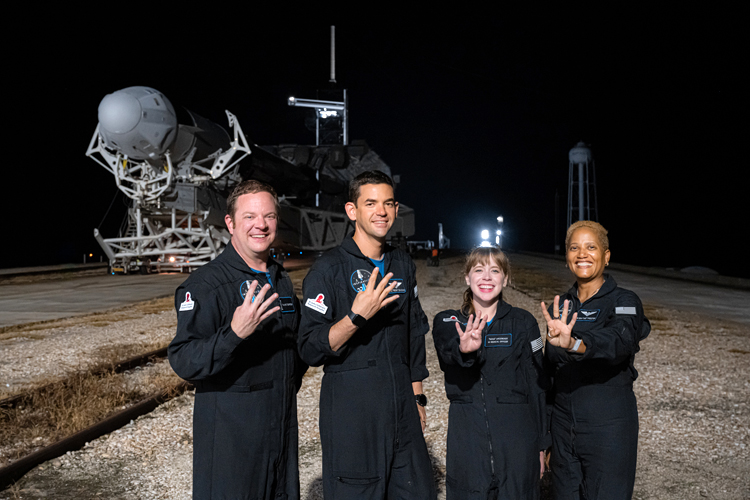
This year, not only has the space industry witnessed expansion but space tourism is also widening its prospects like never before. The most recent testimony to that is SpaceX’s Inspiration4 mission. After orbiting the Earth for three days, the astronauts of Inspiration4 flying aboard SpaceX’s Dragon spacecraft safely returned. This marked the completion of the world’s first all-civilian human spaceflight to orbit, which launched on a flight-proven SpaceX Falcon 9 rocket from the historic Launch Complex 39A at NASA’s Kennedy Space Center in Florida on September 15, 2021.
Since the mission’s announcement in March 2021, the Inspiration4 crew went through a wide range of training activities including centrifuge training, Dragon simulations, observations of other launch operations, Zero-G plane training, altitude training and additional classroom, simulation and medical testing before the actual flight. The four crew members participated in several activities while in space including a live inflight update, a recorded interview with a few patients of St. Jude Children’s Research Hospital, ringing the closing bell of the New York Stock Exchange, and talking with a number of supporters including actor Tom Cruise, SpaceX Chief Engineer Elon Musk, and the crew’s families and close friends.
Dragon Civilian Crew
The four crew members of Inspiration4 represented the mission pillars of leadership, hope, generosity, and prosperity. In the same order, the crew members who were introduced in March were:
The Inspiration4 crew went through a wide range of training activities including centrifuge training, Dragon simulations, observations of other launch operations, Zero-G plane training, altitude training and additional classroom, simulation and medical testing before the actual flight.
- Jared Isaacman, founder and CEO of Shift4 Payments, who created the Inspiration4 mission and donated the three crew seats alongside him aboard Dragon to individuals from the general public to inspire humanity and raise money for the lifesaving mission of St. Jude. The 38-year old world record-holding pilot and adventurer served as the mission commander, representing leadership.
- Hayley Arceneaux, who represented hope, is a physician assistant at St. Jude Children’s Research Hospital and pediatric cancer survivor. The 29-year-old works at St. Jude Children’s Research Hospital and was treated as a child for bone cancer at the hospital and vowed to return to serve others. Arceneaux served as Medical Officer overseeing medical care and experiments on the mission. Arceneaux who always wanted to become an astronaut became the youngest American, the first pediatric cancer survivor, and the first person with a prosthesis to travel to space.
- Chris Sembroski who represented generosity is a 41-year-old aerospace industry employee at Lockheed Martin and United States Air Force veteran. He contributed to a special fund raising campaign for St. Jude Children’s Research Hospital that offered an Inspiration4 seat to a lucky donor after receiving nearly 72,000 entries. Sembroski served as the Mission Specialist and will help manage payload, science experiments, communications to mission control and more.
- Dr. Sian Proctor, the fourth member representing Prosperity is a 51-year-old entrepreneur, educator, trained pilot and active voice in the space exploration community. She was awarded her seat by being selected as the top entrant of an independently judged online business competition that attracted approximately 200 entries and was conducted by the eCommerce platform Shift4Shop.Proctor served as the Mission Pilot and backed up the commander and supported related needs throughout the mission.
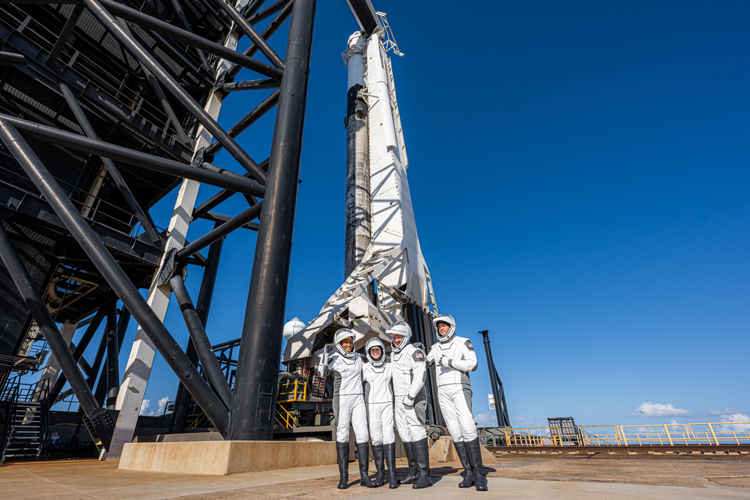
Inspiration(al) Research Report
The mission was not only done solely as a space tourism stint rather involved research that was carried during the three days as part of the mission. Traveling weightless at over 17,000 miles per hour, the crew conducted experiments. Crew Dragon’s 365lbs cargo capacity was allocated for both crew essentials as well as scientific equipment dedicated to micro-gravity research and experimentation, stated the mission’s official statement. “Inspiration4 is committed to assigning the maximum possible mass towards this valuable research, providing access to space for inspiring projects that are otherwise unable to overcome the high barriers of traditional space-based research.”
In a first-of-its-kind health research initiative the crew performed carefully selected research experiments on human health and performance.
In a first-of-its-kind health research initiative the crew performed carefully selected research experiments on human health and performance, to strengthen the understanding of spaceflight’s impact on human body. Additionally, SpaceX, the Translational Research Institute for Space Health (TRISH) at Baylor College of Medicine and investigators at Weill Cornell Medicine have collected environmental and biomedical data and biological samples from Inspiration4’s four crew members before, during, and after this spaceflight. They aim to continue broadening access to space medicine research by making all biomedical data collected for the Inspiration4 mission accessible through an open data repository funded and overseen by TRISH. Empowered by NASA’s (National Aeronautics and Space Administration) Human Research Program, TRISH is a virtual institute that finds and funds disruptive science and medical technology in order to reduce health and performance risks in space explorers.
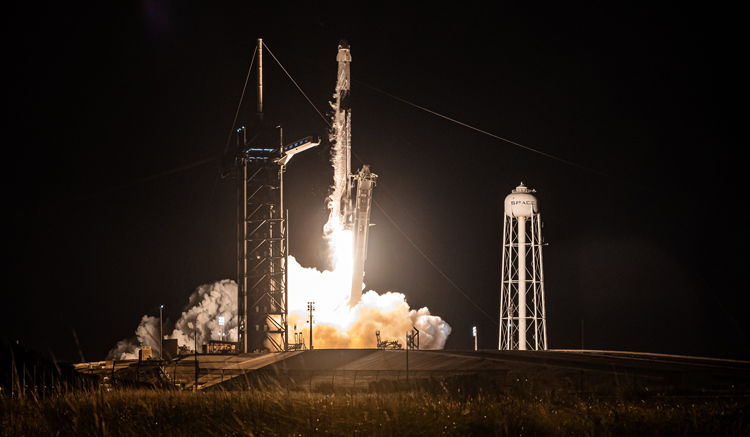
The Inspiration4 Crew Conducted the following TRISH-Sponsored Research:
- Collected research-grade ECG activity, movement, sleep, heart rate and rhythm, blood oxygen saturation, cabin noise and light intensity.
- Performed a series of tests in the Cognition app designed to assess changes in behavioral and cognitive performance. This is the same app that is currently used by astronauts in NASA-funded research studies.
- Scanned organ systems via a Butterfly IQ+ Ultrasound device, which is designed with artificial intelligence guidance for non-medical experts. Data collected will determine if non-medical experts can self-acquire clinical grade images without guidance from ground support and will provide a timeline of biological changes before and during spaceflight. This device is also currently being tested by astronauts on the International Space Station (ISS).
- Collected and tested drops of blood during spaceflight for markers of immune function and inflammation using a state-of-the-art miniaturised device called the Vertical Flow Immunoassay (VFI).
- Used balance and perception tests pre-flight and immediately post-flight to measure sensorimotor adaptation during changes of gravity. These tests are currently performed by astronauts upon return from spaceflight.
- Archived, fully analysed, and shared resulting biomedical samples and data
The mission surpassed its fundraising goal and raised more than $210M and counting for St. Jude Children's Research Hospital to give hope to all kids with cancer and other life-threatening diseases.
SpaceX has also collaborated with investigators at Weill Cornell Medicine to perform a longitudinal, multi-omic analysis of the crew, including genome, epigenome, transcriptome, proteome, microbiome, metabolome, exosome, telomere, single-cell V(D)J immunophenotyping and epitope maps, and spatial transcriptome analysis. These samples and data will be added to a planned Biobank that will hold cryogenically-frozen samples and data from the Inspiration4 mission. It will bear aliquots of the human, microbial, and environmental specimens that are collected before, during, and after missions and enable long-term research and health monitoring for astronauts.
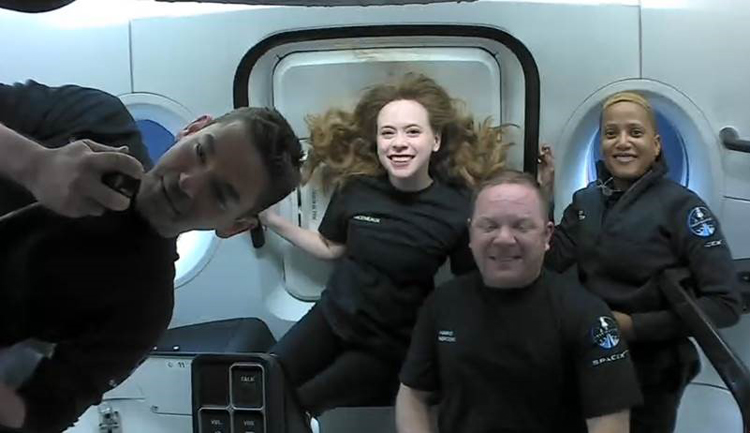
Uplifting Space Science and Social Support
The crew also had a collective goal to make a significant contribution in the fight to cure childhood cancer back on Earth. Started by an initial $100 million (M) gift from Isaacman to St. Jude Children's Research Hospital, Inspiration4 had a fundraising goal to raise $200 million through February 2022 to help accelerate research advancements and save more children worldwide. However, the mission surpassed its fundraising goal and raised more than $210 million and counting for St. Jude to give hope to all kids with cancer and other life-threatening diseases, $50 million from this was pledged by SpaceX founder, Elon Musk.
Apart from the duration and miles, the extensive research carried aboard the Inspiration4 mission along with the funds it helped raise have been some major defining as well as differentiating markers for the mission as compared to Virgin Galactic and Blue Origin’s human spaceflight.
Astronauts taking interesting items into space has almost become a tradition, starting from the very first Mercury mission in 1961. But with Inspiration4 crew took not just personal mementos but things that didn’t exist even a year ago to make the auction item list further more interesting. Their payload included the first-ever minted NFT (non-fungible token) song to be played in orbit, created by the Grammy Award-winning rock band Kings of Leon. It was played about Dragon by Arceneaux. The minted NFT, a never-before-released performance of “Time in Disguise” from the band’s newest album, was among a handful of unique items that went into orbit, to be auctioned off on YellowHeart to support St. Jude Children’s Research Hospital.
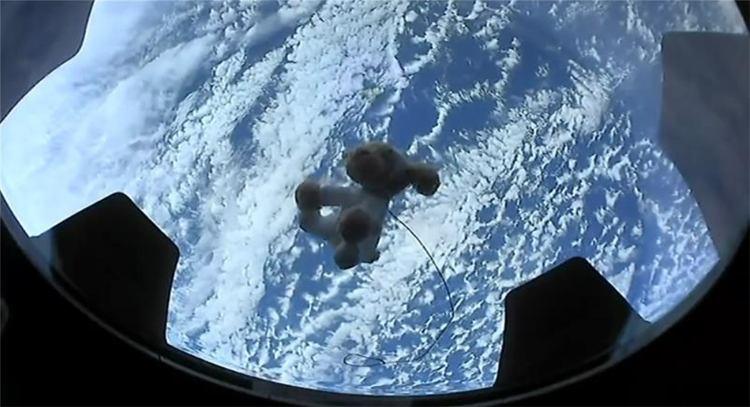
The Inspiration4 payload auction items included a variety of iconic and culturally significant items donated to St. Jude, including:
- Inspiration4 mission jackets featuring unique artwork by St. Jude patients, and original artwork by the Inspiration4 crew members, that were created by Space for Art Foundation co-founders artist Ian Cion and retired NASA astronaut Nicole Stott, and handmade by spacesuit replica artist Ryan Nagata.
- 66 pounds of hops that, upon return, will be used to brew an out-of-this world beer by the brewers of Samuel Adams. As the official beer of Inspiration4, Sam Adams has committed a maximum $1,00,000 donation to St. Jude.
- A Fisher Apollo 11 50th Anniversary Space Pen & Coin Set containing a piece of material from Apollo 11.
- A ukulele from Martin Guitar that crew member Chris Sembroski played in space.
- 50 art NFTs from 50 different artists to be auctioned on Origin Protocol's NFT platform in collaboration with Subtractive, including an NFT that crew member Dr. Sian Proctor took into space that was also a piece of physical art that previously traveled to the Mariana Trench, making it the first piece of art that went to the furthest ocean depths and then into orbit.
- A handful of plastic and plush STEM toys based on the five characters from the popular animated STEM series, “Space Racers.”
- A mini-astronaut plush that will be delivered to the winning bidder with an original collar designed by renowned artist Romero Britto.
- The recent TIME magazine with cover feature of the four crew members, autographed after the Dragon’s returns.
- IWC Schaffhausen has designed and donated four unique, space-themed Pilot’s Watch Chronographs representing the mission’s values of Leadership, Hope, Generosity and Prosperity. The Pilot’s Watch Chronograph Edition Inspiration4 watches were worn by the four crew members on their journey into space, before being auctioned off to benefit St. Jude.
- Customised Montblanc StarWalker Writing Instruments and stationeries for the crew to write about their journey in space.
Firsts
SpaceX’s mission completed several historic firsts during this mission, including:
- First all-civilian human spaceflight to orbit
- First black female spacecraft pilot
- Youngest American in space
- First person to fly to space with a prosthetic
- Farthest flight for a human spaceflight since the Hubble missions
- First time SpaceX has operated three Dragons in space
- First free-flight of a Dragon spacecraft on a human spaceflight mission, i.e. the first orbital human spaceflight mission that did not dock with a space station
- Largest contiguous window ever flown in space
- First splashdown of a Dragon crew in the Atlantic Ocean
- First thrice-flown Falcon 9 booster to launch a human spaceflight mission
A couple of months back Richard Branson’s Virgin Galactic and Jeff Bezos’ Blue Origin also took humans to space. However, Elon Musk lead SpaceX’s Inspiration4 is different from those in many sense. The miles that the Dragon spacecraft travelled were over 360 which is even higher than what the ISS achieved. Branson and Bezos’ spaceflights hardly surpassed the Karman line, the internationally recognised boundary from where space begins. The duration for which SpaceX crew were in space was also significantly more as compared to a few minutes for which the other two spaceflights experienced zero gravity. The extensive research carried aboard the Inspiration4 mission along with the funds it helped raise have been some other major defining as well as differentiating markers for the mission.
Insipration4 has been a success for space exploration as well as space commercialisation in the times to come. As the space tourism industry surfaces, this mission has been a major stepping stone for its creation. SpaceX would hope this mission to be a beginning to many more in line where Dragon would be used for commercial missions giving ride to tourists and/or private researchers.





